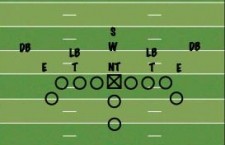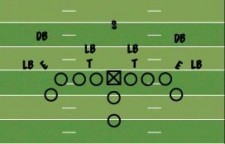Defending The Double Wing Part II
Specific defensive calls to make
There are some specific defensive calls you can make to stifle the Double Wing.
Attack Option
 DIAGRAM 1: Attack Option. The cornerback in the direction of the motion steps in over the wingback and plays like a defensive end. If a team has having success going outside, this is a good counter.
DIAGRAM 1: Attack Option. The cornerback in the direction of the motion steps in over the wingback and plays like a defensive end. If a team has having success going outside, this is a good counter.
Attack Opposite
 DIAGRAM 2: Attack Opposite. Another wrinkle is to blitz the cornerback who is on the side the wingback has vacated (opposite the motion). This puts pressure on the quarterback, so it’s especially effective in passing situations.
DIAGRAM 2: Attack Opposite. Another wrinkle is to blitz the cornerback who is on the side the wingback has vacated (opposite the motion). This puts pressure on the quarterback, so it’s especially effective in passing situations.
The safeties play six to eight yards deep and key on the quarterback. The defensive backs must pick up the motion quickly and rotate into a three-deep coverage — and then make lots of tackles.
50 Cover 3
 DIAGRAM 3: 50 Cover 3. The cornerbacks set up a little deeper and each has deep third responsibility along with a single safety. The second safety now becomes a linebacker, and the three linebackers are stacked behind the two tackles and the nose tackle.
DIAGRAM 3: 50 Cover 3. The cornerbacks set up a little deeper and each has deep third responsibility along with a single safety. The second safety now becomes a linebacker, and the three linebackers are stacked behind the two tackles and the nose tackle.
50 Wild
 DIAGRAM 4: 50 Wild. The formation is the same as in 50 Cover 3, but the freed-up safety now becomes a spy, following one of the four backs. This is especially effective if the opposition has one offensive player it relies on in clutch situations.
DIAGRAM 4: 50 Wild. The formation is the same as in 50 Cover 3, but the freed-up safety now becomes a spy, following one of the four backs. This is especially effective if the opposition has one offensive player it relies on in clutch situations.
Four-Man Front
 DIAGRAM 5: Four-Man Front. The tackles line up on the guards just as they would on the offensive tackles, and the defensive ends stay in the same spot as in the 5-2. The extra linebackers, though, now play where the cornerbacks were before, but instead are on the line of scrimmage.
DIAGRAM 5: Four-Man Front. The tackles line up on the guards just as they would on the offensive tackles, and the defensive ends stay in the same spot as in the 5-2. The extra linebackers, though, now play where the cornerbacks were before, but instead are on the line of scrimmage.
The linebackers stack behind the tackles and the corner backs are behind and between the end and outside linebackers. The outside linebacker opposite the motion drops into coverage, and the single safety takes the middle third.
It’s still possible to run Attack and Attack Opposite out of the four-man front but there is a weakness off tackle.
Defending The Passing Game
If the quarterback rolls to the motion side, the weak-side tight end runs a post. The strong-side wing and tight end vary their routes, but one runs a flag, and the other goes to the flat.
Another option for the offense is to send the strong-side tight end straight down the middle of the field, with the other tight end deep on the weak side.
The latter option attacks the basic Cover 2 defense, as the safety in the middle must take the strong-side tight end, and there’s no one deep on the weak side.
If the defense has three deep defenders, the quarterback floods the weak side with a tight end going deep, the fullback in the flat and the strong-side tight end down the middle. In a five-man front, there’s no one in the weak-side flat, though in a four-man front the outside linebacker takes it away.
It’s important, then, to vary defensive backfield coverages. If the defense sticks in a three-deep, there are plays to attack it, and the same with a two-deep. Bruich has found that showing a two-deep but shifting to a three-deep, and vice versa, is an effective way to stop the Double Wing passing game.





